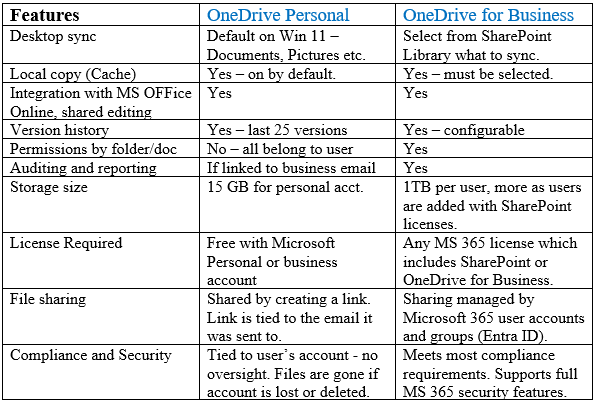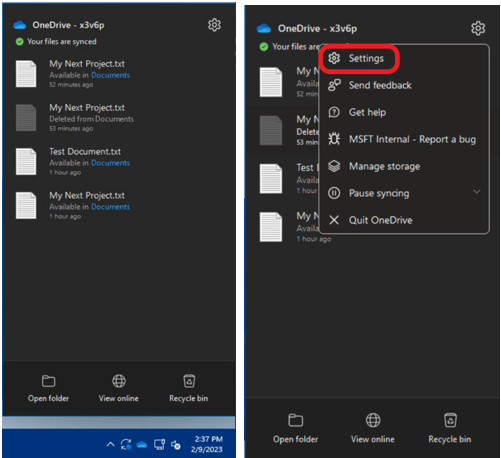OneDrive for Business
Download
Summary: OneDrive provides online file storage and can be a compelling alternative to using a server. This article describes what it is, how it works, and when you might want to consider it as a file server alternative.
What is on-premises storage?
On-premises storage means your company’s server is hosted within your organization’s infrastructure and, in many cases, physically onsite. The server is controlled, administered, maintained, procured, etc., by your company, its in-house IT team, or an IT partner. Data and other information are shared between computers through your local network.
What is cloud storage?
With cloud storage, an outside service provider such as Microsoft hosts your data. The cloud provider procures, installs, and maintains all hardware, software, and other supporting infrastructure in its data centers. You access these services and manage your account via the internet from your PC, a web browser, or a mobile app.
Microsoft OneDrive is an online service that provides file storage. It is similar to Google Drive, Dropbox, Box, and other file-sharing services – they all store files online, which you can access from your computer.
OneDrive was released in 2007 as SkyDrive and became part of Windows Live. In 2014, it was renamed to OneDrive. It is sometimes called OneDrive personal, to distinguish it from OneDrive for Business.
Windows 11 users are pushed toward setting up a OneDrive account during the initial setup of Windows. If you follow the prompts, you will create or connect to a personal OneDrive account linked to your email, and your computer’s documents will be stored (redirected) in your OneDrive account online, with a local copy on your PC.
Microsoft has a similarly named software-plus-service offering called OneDrive for Business. While OneDrive is a personal storage service on the web, OneDrive for Business is managed cloud storage for business users. Files are hosted in SharePoint document libraries. SharePoint is Microsoft’s intranet/website product. This is the product that businesses may want to look at as an alternative or supplement to a file server.
The OneDrive client app is software that runs on your computer. It comes with Windows 11 and can be downloaded for Windows 10, Mac, iPhone/iPad, and Android.
When set up, the app synchronizes the online files to a folder on your computer. You can select to download all files or just the ones you open – both to the local folder. This is called caching the file – creating a local copy. The local copy can be edited (if cached) even if you don’t have internet access.
The OneDrive app works with both OneDrive (personal) and OneDrive for Business. Each set of files shows up in separate local folders. This can be confusing. It will help to consider OneDrive (personal) and OneDrive for Business as entirely separate products that happen to have a similar name and share the desktop client. There are versions of the OneDrive app for Mac and mobile phones.


One significant benefit of OneDrive is the integration with Microsoft Office apps. Multiple people can work on the same Word, Excel, OneNote, and PowerPoint document if stored in OneDrive. OneDrive files integrate with Teams, and OneDrive for Business is built into SharePoint. MS Office Online Apps (Word, Excel, OneNote, PowerPoint, and Outlook) require that documents be saved in OneDrive – even if you save them back to your Desktop after editing. OneDrive for Business also provides version control – you can open a previous version of the file. Search, including searching within documents (including PDF), is supported. You won’t want to switch back once you experience the convenience of working together on files.
This is why we recommend OneDrive over other online file storage offerings for MS Office users. If you use Google products, Google Drive is a better solution.
OneDrive for Business is included as part of many Microsoft Office offerings including Microsoft 365 Business Basic and above, and Office 365 – anything that includes SharePoint. There is no additional cost for most MS Office users. OneDrive can also be purchased as a standalone plan.
OneDrive does not work with many programs that require a server database. This includes QuickBooks, CAD software, UPS WorldShip, most ERP systems, and anything that uses a SQL database.
Even if you still need a file server for these applications, moving some shared files to OneDrive for Business may make collaboration easier – particularly if you are in multiple locations or working from home.
Setting up a file system requires careful thought about who should have access to files and how they are organized into folders.
SharePoint document libraries provide the storage for OneDrive for Business. You will probably need expert help to set it up correctly. OneDrive for Business can mimic the granular security of a file server if planned well. It can be a security nightmare if not set up correctly.
Security for OneDrive for Business files are set by the SharePoint Document Library security settings. Access to OneDrive for Business is based on the User’s MS 365 email address. Security groups are created and managed in the MS 365 user portal settings (now called Microsoft Entra). These users and groups are assigned rights to the Document library, folders, and files.
OneDrive will not allow some characters and filenames that are valid for file servers.
If you are interested in OneDrive for Business, contact us for help setting it up and planning for the transition from your current file system.
Resources:
Seeing files shared from a personal account.
OneDrive for Business Administration
OneDrive Video training
Tim Torian


